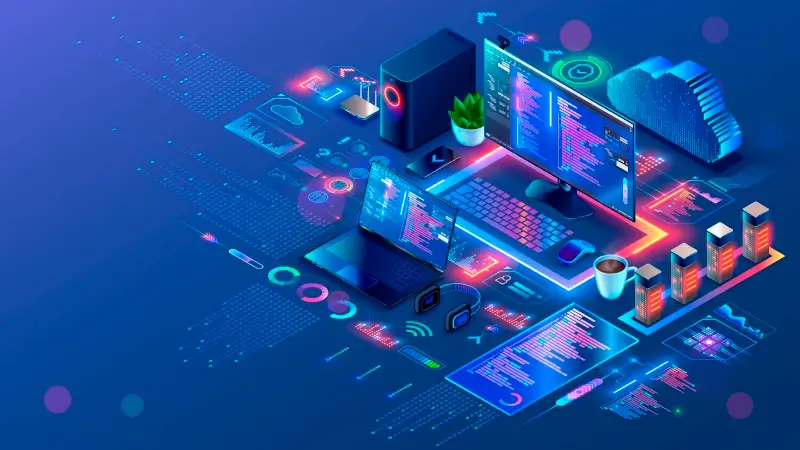Software development is the process of creating and designing computer programs or applications through coding, design, testing, and maintenance. This process involves a series of steps and instructions that developers follow to create functional and high-quality software. It encompasses all the processes involved in development, from inception, production, review, delivery, to subsequent maintenance.
Software is a set of rules or programs that instruct the computer on what actions to perform, allowing computers to be programmable.
The significant importance and relevance of software development stem from the fact that an increasing number of companies, of all sizes, have started using business software to seek greater efficiency in various areas of work. It enables them to manage customer data, handle emails, work-related aspects, and much more.
Next, we will explain how software development and creation work, and we will mention examples to understand how software management is applied in daily life in different fields.
Software Differentiators
To gain a competitive edge over competitors and implement technological innovations in software, certain features should be present to achieve greater efficiency, data quality, and streamlined processes:
- Artificial Intelligence: AI allows software to mimic human decision-making. Acquiring knowledge or learning in these areas enables software to have an advantage over the competition. This is due to the inclusion of artificial intelligence as a complement to applications through application programming interfaces or APIs.
- Native Cloud Development: The ability to create applications to make the most of cloud environments. A native application contains discrete and reusable components (microservices) designed to integrate into any cloud environment. Due to its design and architecture, these applications can enhance performance, scalability, flexibility, and extensibility.
- Cloud-Based Development: Development environments of this type allow coding, integration, design, testing, and more development functions. It also provides access to APIs, DevOps development, microservices, and other service and experience tools.
Software Development Process
To achieve the correct implementation and development of software, it is necessary to follow and comply with a series of basic requirements:
1. Requirements: The process begins with the identification of software requirements, involving understanding what the user is looking for and defining the features and functionalities the application should have.
2. Design: Developers create a detailed design of the software, including system architecture, user interface, data structure, and other technical aspects. This determines the initial foundation for software construction and development.
3. Implementation: In this phase, programmers write the source code of the software following the previously established and defined design. Programming languages and specific tools are used to create the required software.
4. Testing: The software undergoes comprehensive testing to identify and correct errors. It ensures that it functions according to the requirements specified in the initial stages. This includes cohesion tests, combination tests, and user approval tests.
5. Deployment: Once the software completes and passes the required tests, it is considered ready for use and is implemented in a production environment. It can be released internally within a company or publicly for users.
6. Maintenance: The software undergoes continuous maintenance to correct errors, add new features, and improve performance. This phase has no time limit and depends on the software's lifespan and functionality.
Examples of Software Development
There is a wide variety of software, and there are increasingly more for different areas or industries. These contribute to increased efficiency or improvement in the ways companies operate:
Enterprise Management Software: These platforms allow the management, automation, and integration of various processes within a company on a single platform. This enables them to make efficient decisions with better and more relevant data and information in real-time.
The most well-known management systems are:
- CRM (Customer Relationship Management): Manages customer data and potential customers, automates sales and marketing, streamlining processes for businesses of all sizes and increasing benefits.
- ERP (Enterprise Resource Planning): Enables companies to increase the flow of data and information that improves productivity and efficiency. This enterprise software is adaptable to companies of all sizes, from small and medium enterprises (SMEs) to multinational corporations.
learn more about Creatio CRM
Operating Systems: These operating systems manage hardware resources and allow programs to run on a computer or mobile device. Some examples include Microsoft Windows, macOS, Linux, Android, and iOS.
Productivity Applications: A variety of applications that allow users to create and manage documents, spreadsheets, and presentations. The most well-known and used ones are Microsoft Office (Word, Excel, and PowerPoint) and Google Workspace (formerly G Suite).
Web Applications: These applications run on web browsers, allowing and providing online services such as social networks, commerce, and emails. The most well-known examples are Facebook, Twitter, Amazon, and Gmail.
Mobile Applications: Applications that run directly on mobile devices and offer a variety of functions, from messaging to entertainment and transportation. Examples include WhatsApp, Instagram, Uber, and Spotify.
Video Games: Software programs designed for entertainment and leisure for use on various devices. Popular video games include Fortnite, Minecraft, Call of Duty, Candy Crush, and many more.
Scientific Software: Programs used in research and science, such as simulation software, data analysis, and mathematical modeling.
The development of system software is a broad and diverse field that encompasses a wide variety of applications and technologies. The examples above illustrate some of the most common types of software.
Conclusion
In summary, software development is a complex and diverse process that involves planning, design, implementation, testing, debugging, deployment, and maintenance of computer applications. It is a lengthy and meticulous process, but it ultimately yields significant benefits.
Collaboration, effective communication, and the use of appropriate tools and technologies are crucial for the success of a software development project.
Do you have doubts about your processes or want to optimize your software?




